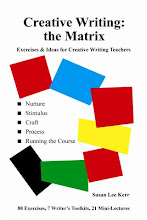In for a penny, in for a pound. Having woven in some Interactive White Board (IWB) [see 23/02/11 blog] for this term's run of Hero's Journey/Writer's Journey I am having a go at PowerPoint.
Here's the question for you: what effect does I.T. have on teaching creative writing?
Now, I ask you, doesn't your heart leap with joy at the word PowerPoint? Not. We have all been to talks/presentations using it, and well know that it's still the talk, the content that matters. However, as we HAVE all been to presentations using it, it's now regarded as standard professionalism. And, actually, our college's classroom technology is now v up-to-date -- ceiling-mounted IT projector, remote control, light pen (for the IWB, not PwrPt), so it's pretty whizzy. And, dear reader, I've done it.
Good effect: in prepping, and determining to do very few slides and to keep the lecture short, I found PwrPt helpful. Looking over my notes and the handout I boiled down to about 2 or 3 main points... just to pop them up there on the screen on hold while I talked. Doing it really focussed my thinking and -- I hope -- my talking. Then on to the writing exercises ASAP.
Not so good effect: by second session I had a couple of rather anxious queries from students saying that their stories did not have, say, a Mentor, or a Threshold (or other of the archetypal elements).
Whoah! For one thing, we hadn't yet covered these, except in the brief overview I gave in the intro about the course. For another, I had said at least twice that there is no such thing as a 'map' or 'writing by numbers' and that these archetypal elements are merely aids or tools.
So, does seeing things projected in B&W make students think in B&W -- that is, does it interfere with creative freedom? Does it inhibit creative writing?
Next session I talked up creative freedom loud & clear. Also brought in a short story, Rosendo's Tale, by Jorge Luis Borges. It's a fine little story, not great, but certainly satisfactory, and has a number of archetypal elements -- not all, and not 'in order'. We discussed and will continue to refer to it -- creative freedom, I hope, illustrated in this use of heroic quest archetypes.
I've told my students that use of PwrPt in this course is new, and so is use of a 'text', and will be asking them for feedback.
Use of the story raises another question for us tutors of creative writing -- does lit-crit help or hinder creative writing in a class?
Next class session: IWB again. Next I.T. challenge for me: moodle?? Experiences, opinions, anyone?


